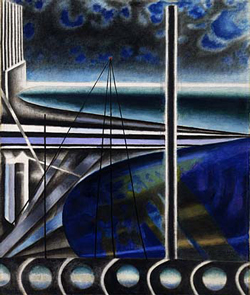
Mid to Late 20th Century Poetry: Roethke, Ginsburg, and Others
Post-World War II literature is a mess.
By that, I mean that there is a much less definable set of characteristics to describe it. In his poem "The Second Coming," Yeats said, "The center cannot hold," and that is what has finally happened in postwar literature. There is no particular "center" to adhere to or rebel against. Postwar literature (sometimes called "Postmodern" literature) is different from Modernist literature in that the authors of the postwar era have accepted a Godless, meaningless universe and are no longer pointing out, with awe and horror, its characteristics. They are simply trying to figure out what to do with it and how to live in it. This literature accepts the absence of a guiding symmetry in the world. God doesn't exist, nor does any world order. Thus, our existence is reduced to a meaningless morass of confusion. In this literature, for the most part, humans are not tragic or heroic. They are comic and pathetic, little more than clowns fumbling their way through an incomprehensible maze. They are observed with both pity and humor by the reader and by the artist who has created them and is now observing them. Postwar literature tries to express the senselessness of the human condition and the inadequacy of any rational approach to life.
A common theme of postwar literature is the isolation of human beings. Human relationships are fragile at best, and are often harmful. Little love or comfort derive from sharing time and space with other characters. They stay together from fear of being alone. Physical love is a mere biological urge; characters are often asexual. When it exists, sex is either ugly and destructive or unsatisfying, reinforcing loneliness rather than banishing it.
Another common characteristic of postwar literature is that values of right and wrong disappear; no moral order exists. All that we can know is relative, based on perspective. This is one of the major themes of Modern literature, of course, but it is even sharper in postwar literature. We can not know the meaning of an event, a poem, a story, a painting--we can only know a meaning. And as our experience or knowledge changes our perspective, so will the meaning change. We are constantly constructing "meaning"; the only constant is change.
Another common theme of postwar literature is the futility of speech. Characters experience an inability to communicate with others, and they fail to understand their plight and its consequences. Language, rather than helping to create order, only adds to the chaos. This increases the loneliness of the characters.
The role of literature in this chaotic world varies, depending upon the author. But in general, literature helps to address the questions of
- the relationship between social and artistic responsibility
- the role of the individual in addressing huge political and social forces
- the role of imagination in constructing a sense of self.
In poetry, several large trends existed side-by-side. The Beat poets of the 1950s (Allen Ginsberg, Lawrence Ferlinghetti, Gary Snyder, and others) rejected the values of mainstream American society. They also rejected Eliot as a mentor, reaching back through William Carlos Williams to Walt Whitman's influence. Ginsberg's Howl pays overt homage to Whitman's Leaves of Grass, and gives us a panoramic view of an America which has wasted its potential and promise and sunk into corruption, intolerance, and materialism. African-American poets such as Gwendolyn Brooks and Amiri Baraka, women poets such as Anne Sexton and Sylvia Plath, Latino and Latina poets such as Pat Mora and Judith Ortiz Cofer, and Native American poets such as Joy Harjo and Simon Ortiz demanded a place in the literary canon, which had previously been dominated by white male voices. T. S. Eliot's poetry had been impersonal and distant; increasingly, postwar poetry became personal and autobiographical--"confessional."
Modern poets had broken with traditional forms, saying they needed new forms to express a new reality; the postwar generation went back to many traditional forms, mixing them, parodying them, or appropriating them for their own purposes. Many postmodern writers argued that true originality was impossible, anyway; all the plots had been written, all the forms had been developed. What was left to the postwar generation, they argued, was fragments, so that's what they used--appropriately enough, since the world was such a fragmented place.
As you read postwar American poetry, you notice that the differences outnumber the similarities. Each group of poets has its own agenda, its own voice, its own styles and techniques. In some ways, the lack of coherence among the various groups reflects the lack of coherence of the postwar world in general, a world in which change is constant, tradition is devalued, and huge economic and political movements attempt to depersonalize every aspect of life. Each group of poets--indeed, each individual poet--addresses this world in a different way. Some look outward and call for social or political reform; some look inward and search for whatever might be left of the soul; others call on cultural traditions in an attempt to find a solid foundation on which to stand. There is only one thing on which they all agree: the poem is a way of "maintaining oneself," as Charles Simic said, "in the face of that multiplicity."
For more information on the individual poets we are reading in this section, see the Links page.
Some of the information in this lecture derives from:
1. Eds. George and Barbara Perkins. The American Tradition in Literature. 11th ed., Vol. 2. New York: McGraw-Hill, 2007.
2. Eds. Susan Belasco and Linck Johnson. The Bedford Anthology of American Literature, Vol. 2. Boston: Bedford/St. Martin's, 2008.
3. Eds. George McMichael, et al. Anthology of American Literature, 9th ed., Vol. 2. New Jersey: Pearson, 2007.
4. Richard Ruland and Malcolm Bradbury. From Puritanism to Postmodernism: A History of American Literature. New York: Penguin, 1991.